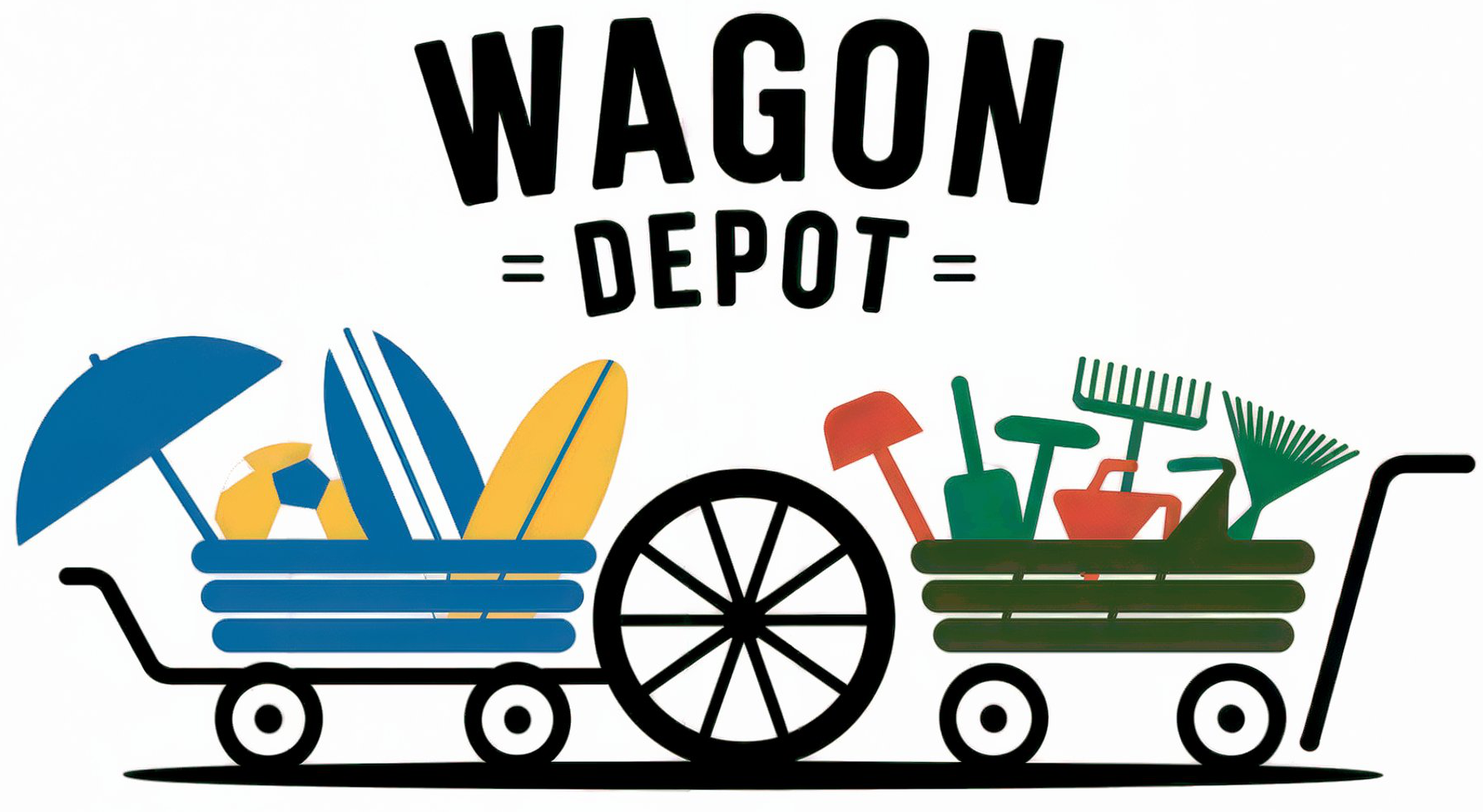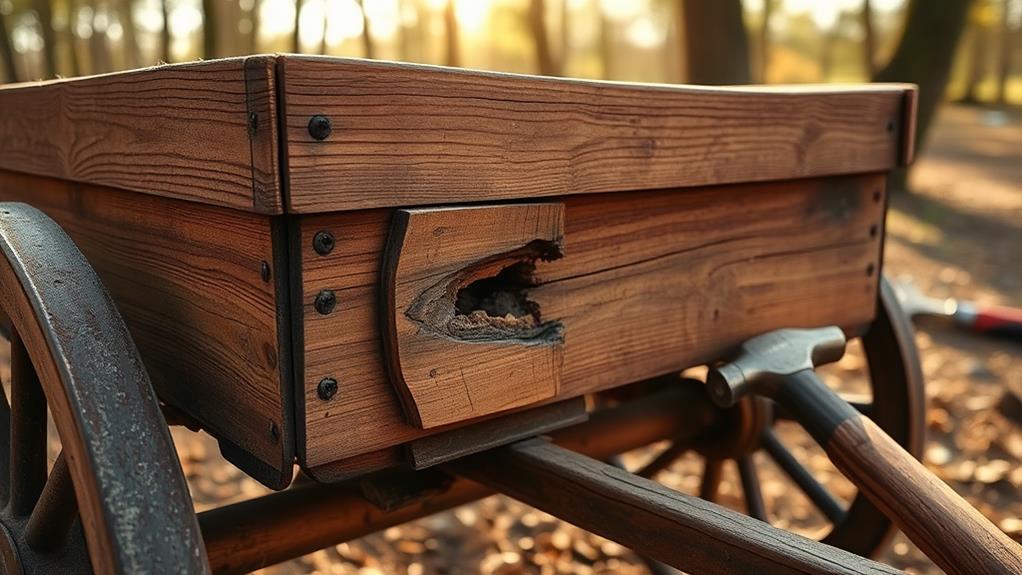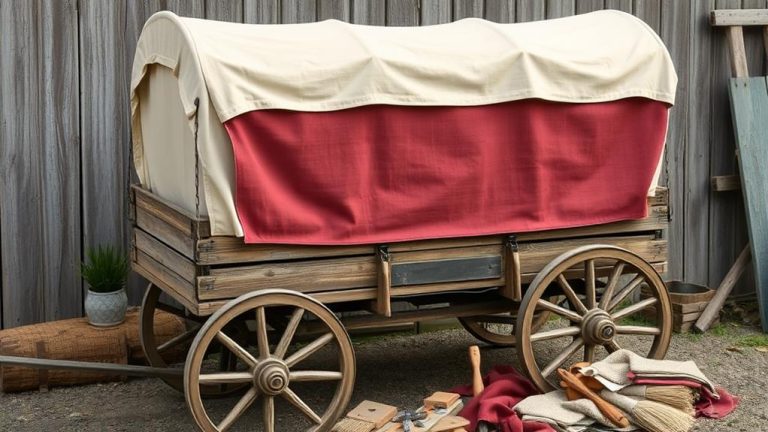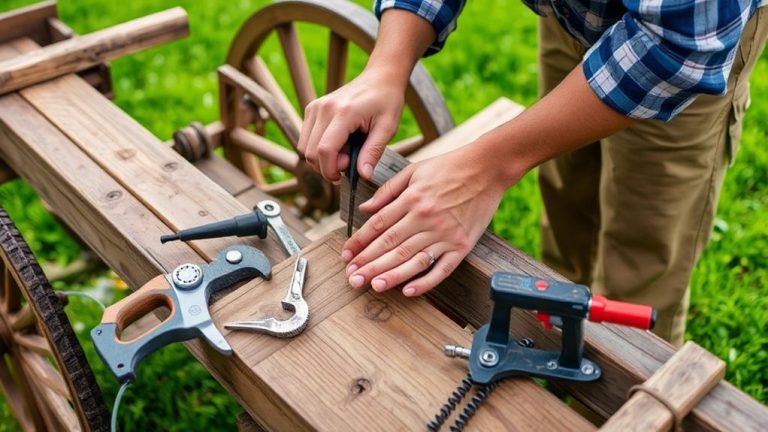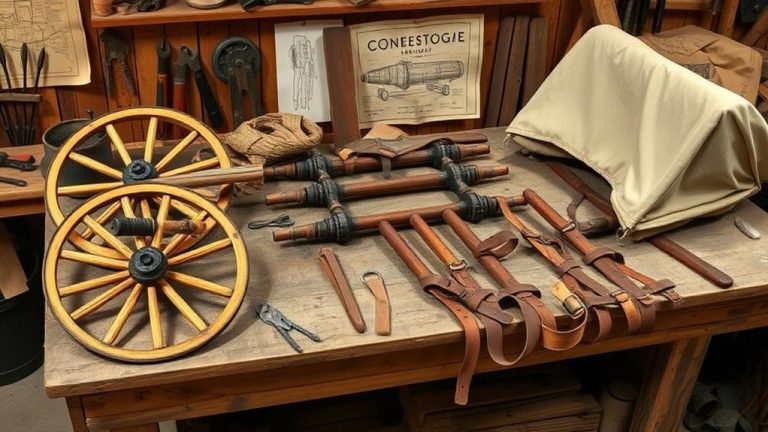To replace your wagon's tongue, start by evaluating its current condition for alignment and wear. Gather necessary tools like a socket wrench and pry bar for efficient work. Choose a compatible replacement tongue based on material and size. Detach the old tongue by removing bolts and disconnecting the hitch. Prepare the new tongue by measuring it accurately for a proper fit. Attach the new tongue, confirming it aligns correctly. Finally, secure all fasteners and conduct a test by connecting the wagon to a vehicle. You'll be well-equipped to guarantee your wagon remains safe and functional as you move forward.
Assessing the Current Tongue
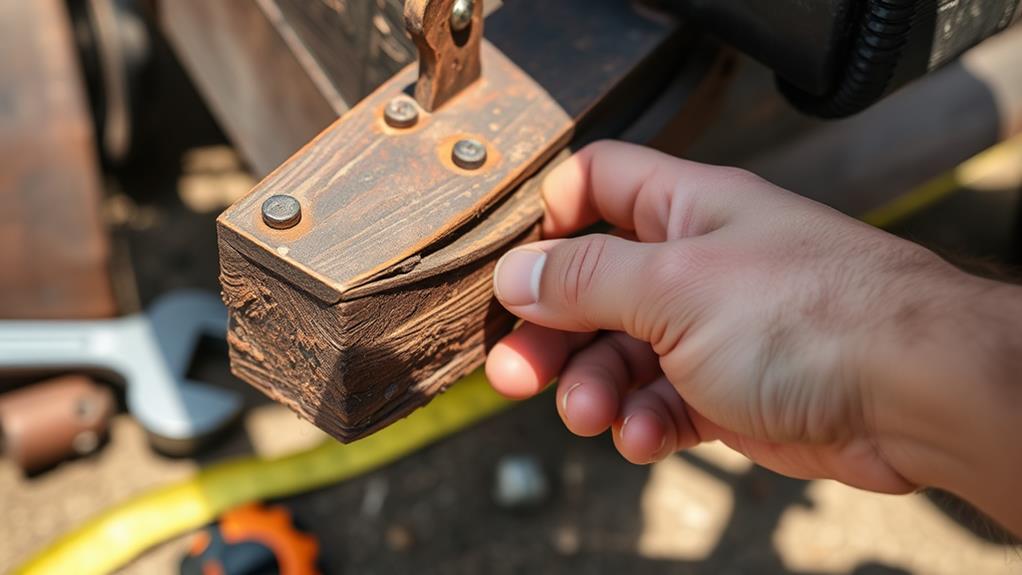
Evaluating the current tongue of your wagon is vital before undertaking any replacement. Start by checking the tongue alignment; any misalignment could lead to instability and unsafe towing. Verify the tongue connects securely to the wagon body and the hitch. Look for signs of wear, such as cracks or bends, which can compromise both the functionality and safety of your wagon.
Next, assess the attachment points. They should be free from rust and corrosion, as degradation at these junctions can weaken the entire structure. Safety considerations are critical; a compromised tongue can lead to accidents, potentially causing damage or injury.
Don't forget to examine the coupling mechanism. It should operate smoothly and lock securely to your towing vehicle. If you notice any issues, it's important to address them swiftly before proceeding with a replacement.
Gathering Necessary Tools
Before starting the replacement process, you'll need to gather several vital tools to guarantee a smooth and efficient job. First, consider the fundamental tool types: a socket wrench set for loosening and tightening bolts, a hammer for driving out stubborn pins, and a pry bar to assist in removing the old tongue. You might additionally find a reciprocating saw useful if you need to cut any materials.
Next, don't overlook safety equipment. A good pair of safety goggles will protect your eyes from debris, whereas gloves can help prevent cuts and scrapes. If you're working with heavy components, consider wearing a hard hat to shield your head from potential impacts.
Lastly, a sturdy workbench or a set of sawhorses can provide stability and support as you manipulate the tongue. Having these tools and safety equipment on hand will not merely make the process easier but will equally improve your overall experience. With the right preparation, you'll be ready to tackle the task confidently, ensuring your wagon remains functional and reliable for all your adventures.
Selecting the Right Replacement
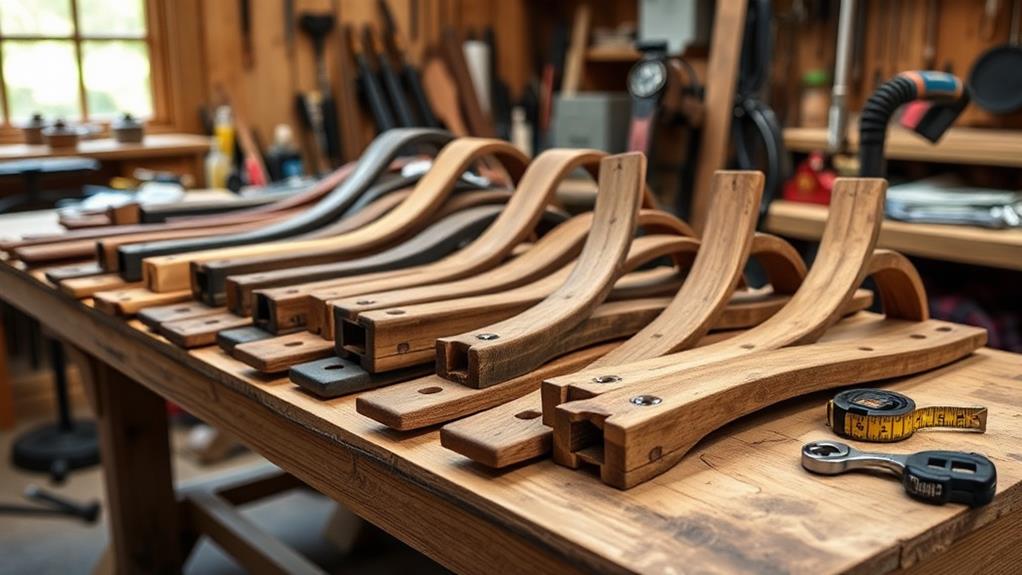
When selecting the right replacement for your wagon's tongue, you'll need to take into account both material options and size compatibility. Common materials include wood, steel, and aluminum, each offering different levels of durability and weight. Ensuring the replacement tongue matches your wagon's specifications is essential for safe and effective use.
Material Options Available
Choosing the right material for your wagon's tongue is crucial for guaranteeing durability and performance. The primary options you'll encounter are wood, steel, and aluminum. Each material has unique advantages and disadvantages that can greatly impact your wagon's functionality.
Wood, although traditional, offers good material durability if properly treated. It's often heavier, so weight factors come into play, especially if you're looking to maintain maneuverability. Steel provides exceptional strength, making it ideal for heavy loads, but it can be much heavier than other choices. This added weight may affect how easily you can pull your wagon over long distances or uneven terrain.
Aluminum is the lightest option, making it easier to handle and transport. It also boasts decent material durability and is resistant to rust, which is a considerable advantage if you frequently use your wagon in wet conditions. Nonetheless, keep in mind that aluminum may not support as heavy a load as steel.
Ultimately, you'll want to evaluate your specific usage needs and how each material aligns with your requirements for weight and durability. This careful selection will guarantee your wagon performs effectively for years to come.
Size and Compatibility Issues
Choosing the right size for your wagon's tongue is vital to guarantee proper functionality and compatibility with your existing setup. When selecting a replacement, you'll need to take into account tongue dimensions such as length, width, and height. These measurements directly impact how the tongue connects to your wagon and influences its towing performance.
Compatibility factors equally play a significant role. Confirm that the new tongue aligns with your wagon's attachment points and is suitable for the type of coupling system you're using. Check the weight capacity of the new tongue to verify it can handle the loads you'll be transporting.
Furthermore, evaluate the materials used in the tongue's construction. Different materials have varying strengths and weight characteristics, which can affect overall performance and durability.
Detaching the Old Tongue
To detach the old tongue from your wagon, you'll need to start by making certain the area is clear and accessible. This means moving any obstacles that might hinder your work. Before you proceed, remember to follow vital safety precautions. Make certain you're wearing gloves and safety goggles to protect yourself from sharp edges and debris.
Begin by locating the bolts or pins that secure the tongue to the wagon body. Using the appropriate tools, typically a wrench or socket set, carefully loosen and remove these fasteners. It's significant to apply consistent pressure to avoid stripping the bolts, a common mistake that can complicate the detachment process.
If your wagon has a hitch mechanism, make certain it's likewise disconnected. Once all fasteners are removed, gently pull the tongue away from the wagon, checking for any residual connections that could snag. Take your time during this step; rushing can lead to accidents or damage.
After detaching the old tongue, inspect the hitch area for any wear or damage. This diligence prepares you for the next phase and guarantees your wagon remains functional and safe for future use.
Preparing the New Tongue
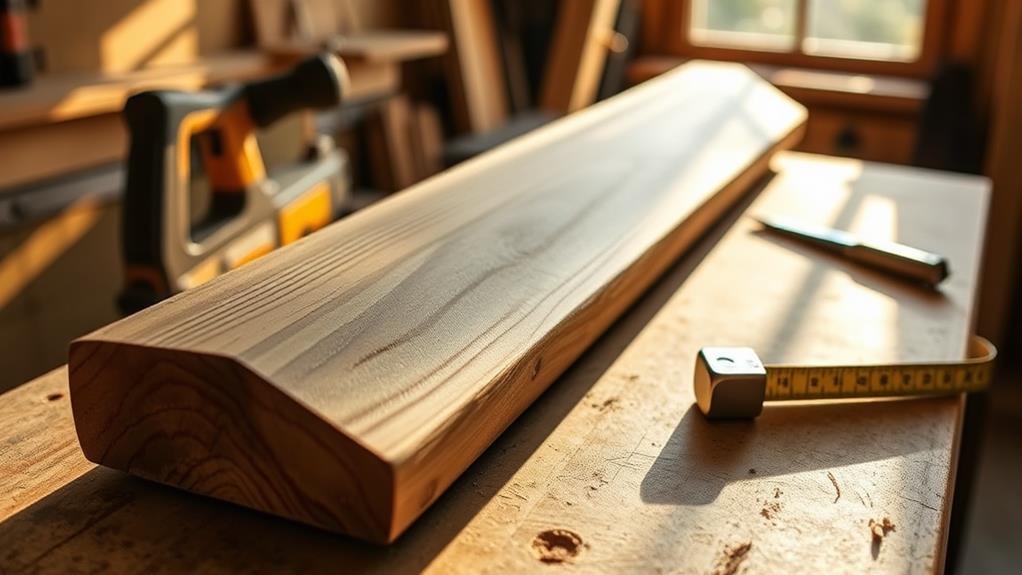
Before you start assembling the new tongue, it's vital to choose appropriate materials that match your wagon's specifications. You'll additionally need to gather the necessary tools to guarantee a smooth installation process. Finally, accurately measure the tongue length to confirm proper fit and functionality.
Choose Appropriate Materials
Selecting the right materials for your wagon's tongue is vital for guaranteeing durability and performance. You'll want to take into account both material durability and weight considerations to optimize your wagon's efficiency. Here are some materials that are commonly used:
- Wood: Provides a traditional feel, but make sure it's treated for weather resistance.
- Steel: Offers high strength and durability, making it ideal for heavy loads but can add significant weight.
- Aluminum: Lightweight and resistant to rust, making it a great choice for ease of mobility.
When choosing your material, think about how much weight your wagon needs to carry and how often you'll be using it. A heavier tongue can impact maneuverability and may require more effort to pull. Conversely, a lightweight option might sacrifice strength under heavy loads. It's vital to strike a balance between material durability and the overall weight of the tongue. This way, you can maintain control and stability during your adventures. With the right materials selected, you'll be well on your way to building a reliable and efficient wagon that meets your needs perfectly.
Gather Necessary Tools
Preparation is key regarding gathering the necessary tools for replacing your wagon's tongue. You'll need to guarantee you have the right tool types at your disposal to complete the task efficiently and safely. Begin with basic hand tools like a wrench, screwdriver, and pliers. These will help you remove the old tongue and attach the new one securely. You may additionally require a saw, particularly if you're customizing the length of the new tongue.
Don't forget about electric tools, like a drill and a reciprocating saw, as they can considerably speed up the process. If you plan to make adjustments, clamps can hold the tongue in place as you work.
Safety equipment is just as essential. Equip yourself with gloves to protect your hands from cuts and splinters, and safety goggles to shield your eyes from debris. A dust mask can likewise be beneficial, especially when cutting or sanding.
Measure Tongue Length
Once you've gathered your tools, the next step involves measuring the tongue length for your new wagon tongue. Accurate measurements are vital to guarantee your new tongue fits perfectly, enhancing both functionality and stability. Here's how to proceed with effective measurement techniques:
- Use a reliable measuring tape for precision.
- Measure from the center of the wagon's hitch to the end of the old tongue.
- Account for any curvature or angles in your existing setup.
Begin your measurement at the hitch point, where the tongue connects to the wagon. Extend the tape along the current tongue, making sure to follow its path accurately. If your existing tongue has any bends, record the measurement straight from the hitch to the tip without including the bend itself, as this will help you maintain the correct length.
Double-check your measurement before cutting any material to avoid mistakes. Once you have the accurate tongue length, you'll be ready to purchase or fabricate your new tongue, guaranteeing your wagon remains a reliable companion on all your adventures.
Attaching the New Tongue
Attaching the new tongue to your wagon is a vital step that guarantees stability and functionality. Start by positioning the new tongue in place, making sure that it aligns correctly with the existing frame. Proper tongue alignment is essential for the overall performance of your wagon; any misalignment could lead to uneven wear or even accidents during use.
Next, you'll want to apply the installation techniques recommended for your specific type of wagon. Typically, this involves using bolts or screws that fit securely into the pre-drilled holes. Be certain you're using the right size and type of hardware to avoid any issues later. It's advisable to hand-tighten each bolt initially to allow for slight adjustments in alignment before fully securing them.
Once you've confirmed that everything is straight and properly aligned, go ahead and tighten the bolts or screws to the manufacturer's specifications. Inspect the joint carefully, checking for any gaps or signs of instability. This attention to detail during the attaching process will help guarantee your wagon's tongue functions effectively, allowing you the freedom to travel without worry.
Securing and Testing
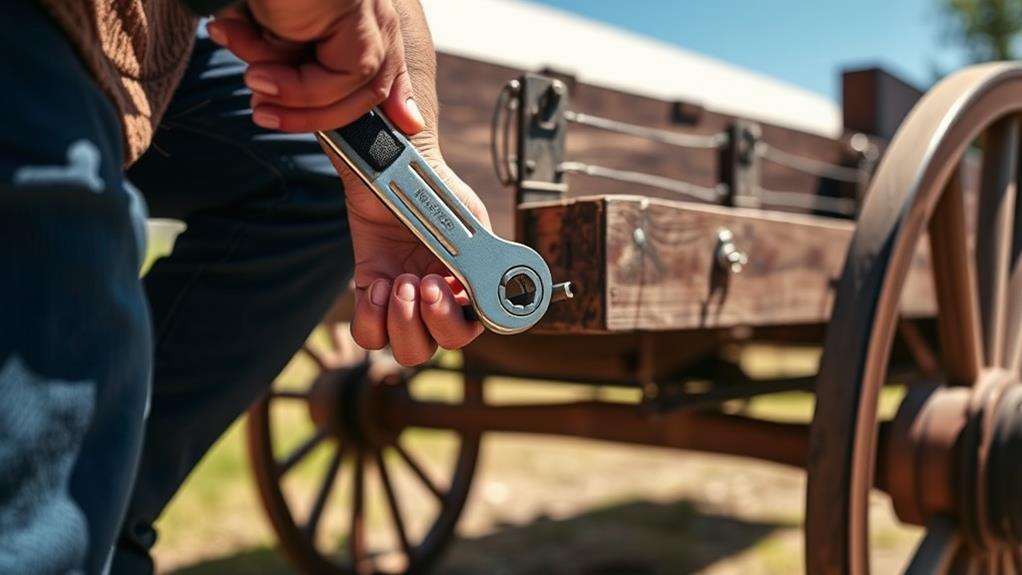
After confirming the new tongue is properly aligned and secured, the next step involves securing and testing the installation. It's vital to double-check that all fasteners are tightened to the manufacturer's specifications. This guarantees peak performance and safety during use.
Here are some important safety considerations to keep in mind:
- Check Tongue Alignment: Make certain the tongue remains aligned with the wagon's frame. Misalignment can lead to uneven weight distribution and instability during towing.
- Inspect Fasteners: Regularly inspect bolts and nuts for wear or looseness. Replace any that show signs of fatigue to maintain structural integrity.
- Test the Connection: Before taking your wagon on the road, conduct a thorough test. Attach the wagon to your vehicle and gently pull it forward. Listen for any unusual noises and watch for signs of instability.
Maintenance Tips for Longevity
Regular maintenance is vital for guaranteeing the longevity of your wagon's tongue and overall towing setup. To achieve this, implement a system of preventative maintenance that includes routine inspections. Start by checking for any signs of wear or damage on the tongue and connecting components. Look for cracks, rust, or bent parts that could compromise structural integrity.
Next, inspect the attachment points where the tongue connects to the wagon and the hitch. Verify that these areas are clean and free of debris, as dirt can lead to corrosion over time. Lubricate moving parts to reduce friction and wear, using a high-quality lubricant suitable for outdoor use.
Furthermore, examine the safety chains and couplers. Verify they're in good condition and properly secured. It's prudent to periodically review the weight distribution on your wagon to prevent undue stress on the tongue.
Lastly, keep a maintenance log to track inspections and any repairs made. This practice not only helps you stay organized but likewise allows you to identify patterns in wear that may need addressing. By following these tips, you’ll improve the performance and lifespan of your wagon’s tongue, guaranteeing freedom on the road. Regularly reviewing your maintenance log ensures you apply the best techniques for antique wagons, preserving their historical value and functionality. Documenting even minor adjustments can help prevent larger issues down the road, saving both time and money. With a consistent maintenance routine, your wagon will remain reliable for years to come.
Frequently Asked Questions
How Often Should I Replace My Wagon's Tongue?
You should replace your wagon's tongue when you notice signs of wear or damage. Regular inspections are essential; it's best to check every season. Tongue maintenance tips include cleaning and lubricating joints to prevent rust and guarantee smooth operation. Address tongue compatibility issues swiftly to avoid safety hazards. If you haul heavy loads frequently, consider more frequent replacements to maintain performance and safety. Prioritize your wagon's integrity for the freedom to roam without worry.
Can I Use a Different Material for the Tongue?
You can definitely use different materials for the tongue of your wagon. In fact, about 60% of custom wagons utilize alternative tongue materials, enhancing durability and performance. When considering tongue design, materials like aluminum or composite plastics can offer lightweight yet sturdy options, improving maneuverability. Just verify the new material can withstand the load and stress your wagon endures. Always prioritize safety and functionality when making your choice to guarantee a smooth ride.
What Are Common Signs of Tongue Damage?
When you're evaluating your wagon's tongue, look for signs of wear like cracks, bends, or splintering. These issues indicate a need for tongue repair and might compromise your wagon's stability. Furthermore, if you notice excessive movement during use or difficulty connecting to the hitch, those are red flags. Regular tongue maintenance can prevent more severe damage, ensuring your wagon remains safe and functional for all your adventures.
Is Professional Help Recommended for Tongue Replacement?
When considering tongue replacement, it's vital to assess your skills and comfort level. During DIY can be rewarding, improper tongue maintenance can lead to safety risks. If you're unsure or lack the tools, professional help's often recommended. They'll guarantee everything's done correctly, minimizing potential hazards. Remember, prioritizing safety is important, especially when dealing with heavy equipment. In the end, the decision should balance your desire for freedom with the need for precision and reliability.
Will Replacing the Tongue Affect My Wagon's Warranty?
Replacing your wagon's tongue can have warranty implications, depending on the manufacturer's policies. If the new tongue doesn't meet the original specifications, it might void your warranty. Always check your warranty documentation before proceeding. Make certain any replacement matches the required tongue specifications to maintain coverage. It's vital to confirm that your modifications don't compromise your wagon's integrity or warranty status, giving you the freedom to enjoy your equipment worry-free.
